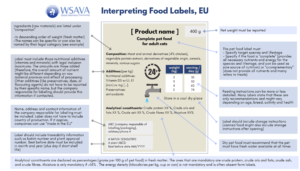In Registered Veterinary Nurse Laura Sproul’s second nutrition blog she covers reading pet food labels – what is in your pet’s bowl?
Figuring out what all the information on your pet’s food means can be really confusing. Here are some useful explanations to help you better understand exactly what you are feeding your pet.
The WSAVA have created a useful guide to help you understand what it all means and what should be on the label:
This is what is required to be included on your pet’s food label – you can download your own copy here.
What certain words mean:
There are a lot of terms used on foods, and many people don’t always know exactly what they mean. This is a small guide to the most common terms:
- Derivatives – derivatives are used usually to describe the meat content in food. A lot of people see the term as a negative. However, it isn’t necessarily. Derivatives are any parts of an animal used for food that are either deemed surplus to human consumption, or parts of the animal not normally consumed by people because we don’t find them appealing. All meat used in pet food comes from the same animals used for human consumption and is handled in the same way as the food we eat. Using the parts we don’t reduces waste and also lowers the cost of pet food by not using meat from the human food chain that can be expensive. Derivatives are usually cooked or dehydrated before being added to food.
- Meal/meat meal – this refers to meat that has been dried and then ground up. It reduces the particle size of the meat.
- Crude – crude simply refers to the method with which food ingredients have been analysed in a laboratory. This is done to check the nutritional value of the food.
- Ash – ash is the residue created from analysing food. It is made up of minerals.
- Fixed formula – a fixed formula food is one where the ingredients are sourced from the same place every time it’s made. It can be more expensive but keeps the food quality consistent. Fixed formulas are good for pets with allergies or intolerances because they reduce the risk of them being exposed to something they can’t digest.
- Open formula – this is a food that changes where it sources it ingredients. This makes the food cheaper but means there are sometimes different things in it.
- Dry matter – this is the content of the food minus any water content or moisture. It is usually used to measure the nutritional value of the food.
Flavouring/ingredient terms-
- ‘Flavoured with’- contains less than 4% of the ingredient
- ‘With’- contains at least 4% of the ingredient
- ‘Rich in’- contains at least 14% of the ingredient
- ‘Dinner’- contains at least 26% of the ingredient
Terms that have no regulation:
There are words that the E.U. don’t regulate the use of when used on packaging.
- Hypoallergenic – unless on the label of a prescription diet used for specific medical conditions this term is fairly irrelevant. It tends to mean that the product either has a single protein source or uses ingredients that pets are less likely to be allergic to such as potato and salmon. Prescription hypoallergenic diets have been formulated in a way that the molecules in the diet have been made small enough to be easily digestible without any adverse reaction (hydrolysed). This isn’t the case in all foods labelled hypoallergenic.
- Human grade – all pet food is made from ingredients that are human grade. This is a requirement for this country. For example, all meat must come from animals used and slaughtered for human consumption. This is done under the observation of a qualified vet to ensure animal welfare and that animals are fit for use.
Other useful facts:
- Ingredients are usually listed in descending order of the weight of the ingredient. Ingredients may be grouped into type e.g. protein instead of the specific meats used, this can be because there is more than one type of meat in the food.
- Pet foods can contain preservatives. These are the same used in human foods to prevent spoilage.
- Grains and cereals aren’t always bad. They are often used to provide the require carbohydrate needed in a balance. Dog and cats can digest them, and like us they can help to keep their heart healthy. Cereals also contain folic acid which is helpful to the brain health of older animals.
Next up, Laura will cover raw and alternative diets.
If you have any questions as a result of these blogs please do get in touch.

